Security Pattern – Source Code Management
Overview
This security pattern outlines controls for protecting company-developed source code from external and internal threats. Source code management is used to track modifications to a repository, maintain a history of changes to a codebase, and resolve conflicts when merging updates from multiple contributors.
Git repositories, as a distributed source code management system, have become the de facto solution for most organisations, replacing traditional centralised source code version control solutions.

Common examples of technology vendors providing source code management include Atlassian BitBucket, GitHub, GitLab, AWS CodeCommit, and Azure Repos.
Typical challenges
- With higher frequencies of changes from multiple contributors, identifying and tracking vulnerable code across source code branches has become more complex.
- Repositories exposed to the public for information sharing require greater consideration than private repositories. This is due to the potential for leaking confidential information, the need to protect intellectual property, and the risk of undiscovered vulnerabilities within application code.
- Secrets or sensitive information can be inadvertently committed to repositories and made accessible to anyone with read access. This is particularly problematic for public repositories accessible to anyone.
- Various developers require direct access permissions across primary, secondary, or local repositories. These developers could be internal staff, partners, or public contributors.
Scope
The scope of this document is for addressing the security threats that relate to
| ID | Description | Example |
|---|---|---|
| 01 | Protection of code being maintained within Git source code repository | Examples of vendors providing source code repository include GitHub, Atlassian Bitbucket, AWS CodeCommit. |
| 02 | Access to source code repository from developers’ workstations. | Local developer workstations (Windows or Linux based) used to clone, branch or merge source code. |
| 03 | Replication of source code repository to 3rd party partners | Source code repositories maybe sync’d or replicated to external service providers or outsourced suppliers. |
Out of Scope
| ID | Description of exclusion | Reason for Exclusion |
|---|---|---|
| 01 | Security controls for software artefact repositories | Considered separate security pattern. |
Dependencies
| ID | Description | Impact from dependency not met |
|---|---|---|
| 01 | Summarised security design principles outlined under Jericho Forum® Commandments. https://publications.opengroup.org/w124 | Minimal impact as these principles are used as an example set of baseline requirements within security pattern. |
Constraints
| ID | Description | Impact from constraint |
|---|---|---|
| 01 | This pattern is constrained to just git version control and not traditional Subversion (SVN) | Minimal impact as SVN is considered depreciated version control mechanism. |
Assumptions
| ID | Description | Impact if assumption is false |
|---|---|---|
| 01 |
Assets at Risk
The following section provides a list of assets affected by the problem statement:
| Asset Title | Asset Description |
|---|---|
| Source Code Management and Version Control | Overall system and management services hosting git repositories and enforcement of version control, system access and audit logs |
| Source Code GIT Repositories – Public | Primary git repository containing source code artefacts configured to allow access from external hosting locations |
| Source Code GIT Repositories - Private | Primary git repository containing source code artefacts configured restricted to private access. These repositories can also be replicated/sync to other remote or partner locations. |
| Developer Workstations | Local developer workstations used by repository owners and contributors to push, pull or commit source code to git repositories. |
| CI/CD Pipelines | Continuous integration and delivery pipelines for maintaining software development lifecycle and workflows. |
The following assets are also referenced within the pattern but not in scope
- Software artefact management - This should be considered within separate security patterns.
- CI/CD Tooling – Underlying tooling used for executing CI/CD Pipelines is considered separate security pattern
- Underlying infrastructure - This should be considered within separate security patterns.
- Collaboration Tooling - Protection of ChatOps and Collaboration tooling integrating with these assets. This should be considered within separate security patterns.
- Remote Access – End user remote access connectivity facilitating access to Source Code Management assets. This should be considered within separate security patterns.
Threat Model
The following section provides a list of threats within the problem statement:
| Threat Event (ID / Title) | Threat Description and Characteristics | Diagram |
|---|---|---|
| TE-09: Accidental leaks or sharing of information due to human error or mishandling | Source code may unintentionally contain sensitive information such as passwords, SSH keys, or access tokens. These can be accidentally checked into the source code repository and subsequently exposed to any malicious entity with read access. | 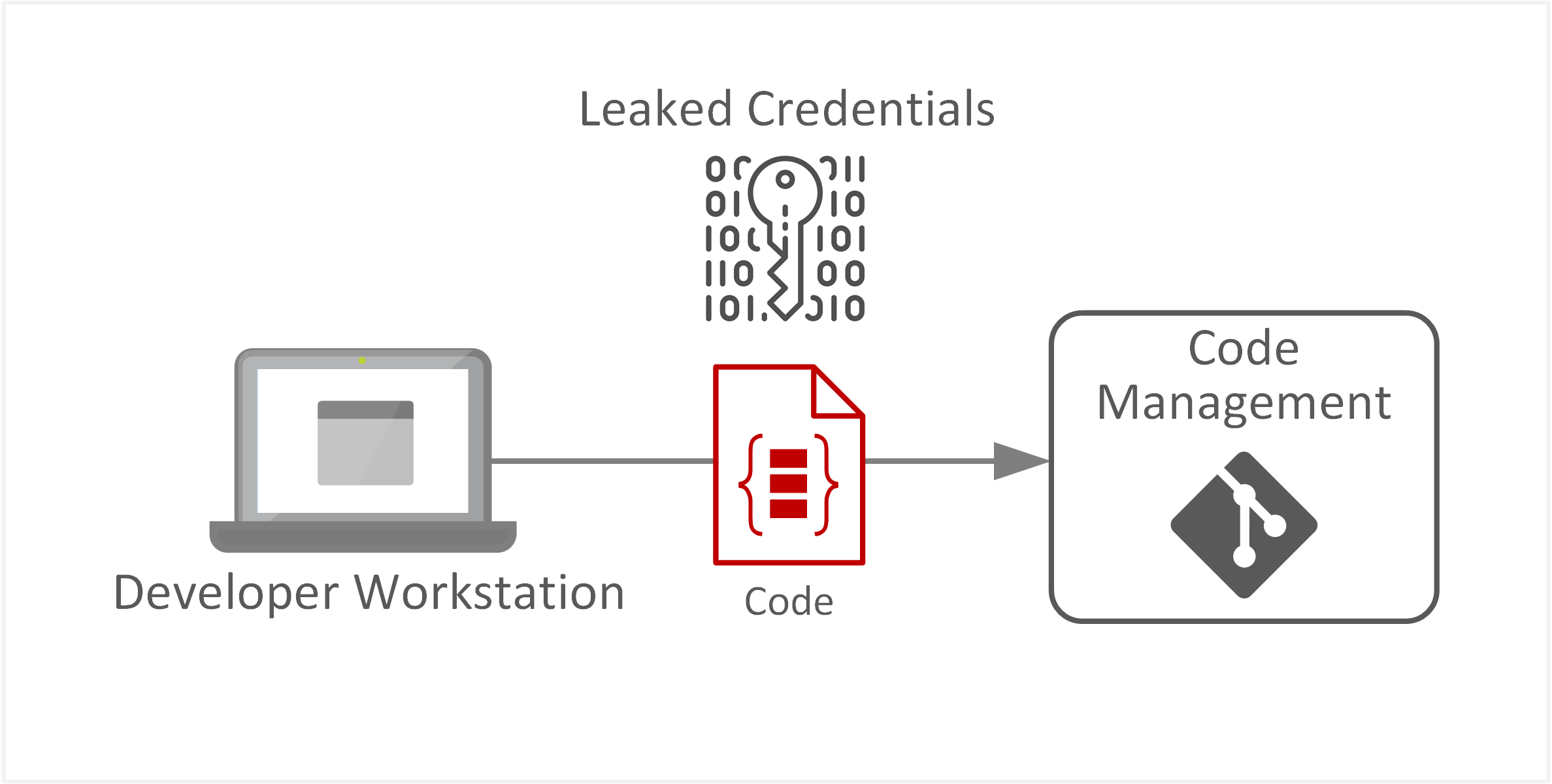 |
| TE-14: Inadequate workflows or processes leading to flaws in deployment | Contributors may unintentionally commit vulnerable code into source code repositories, causing loss of confidence in the target system. Security flaws within code can be introduced at any stage of the software development lifecycle and workflows. Remediated flaws can also be reintroduced due to poor code management practices or development workflows. |  |
| TE-16: Unintentional destruction of records through mismanaged data repositories or storage | Repository or system administrators could unintentionally corrupt or delete source code repositories, resulting in unavailability or inaccessibility of source code. | 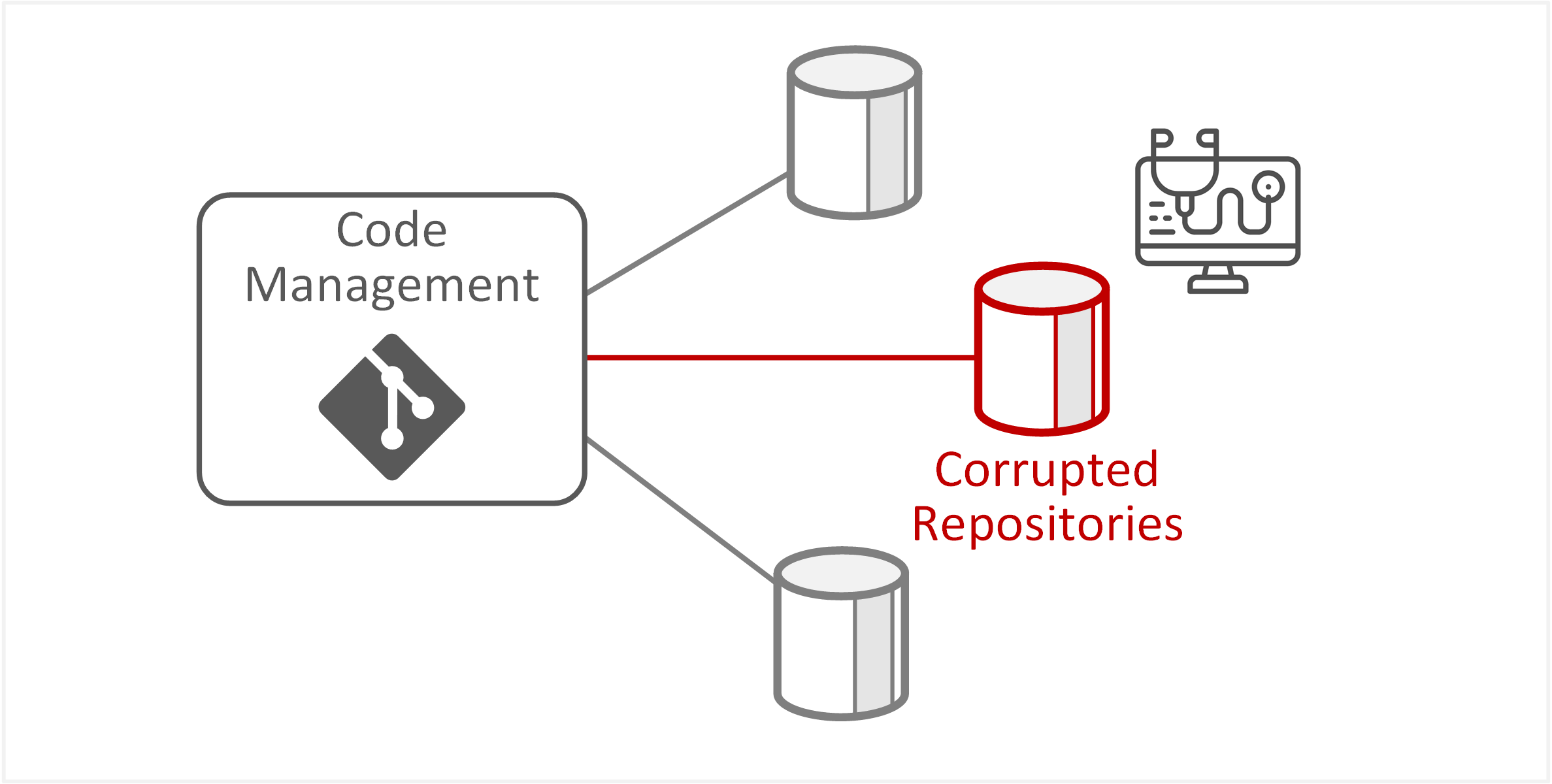 |
| TE-29: Web application attacks or code injection attack | Software used to manage and administer source code repositories may be vulnerable to web application attacks against exposed API interfaces, manipulation of webhooks, or manipulation of command parameters/arguments. | 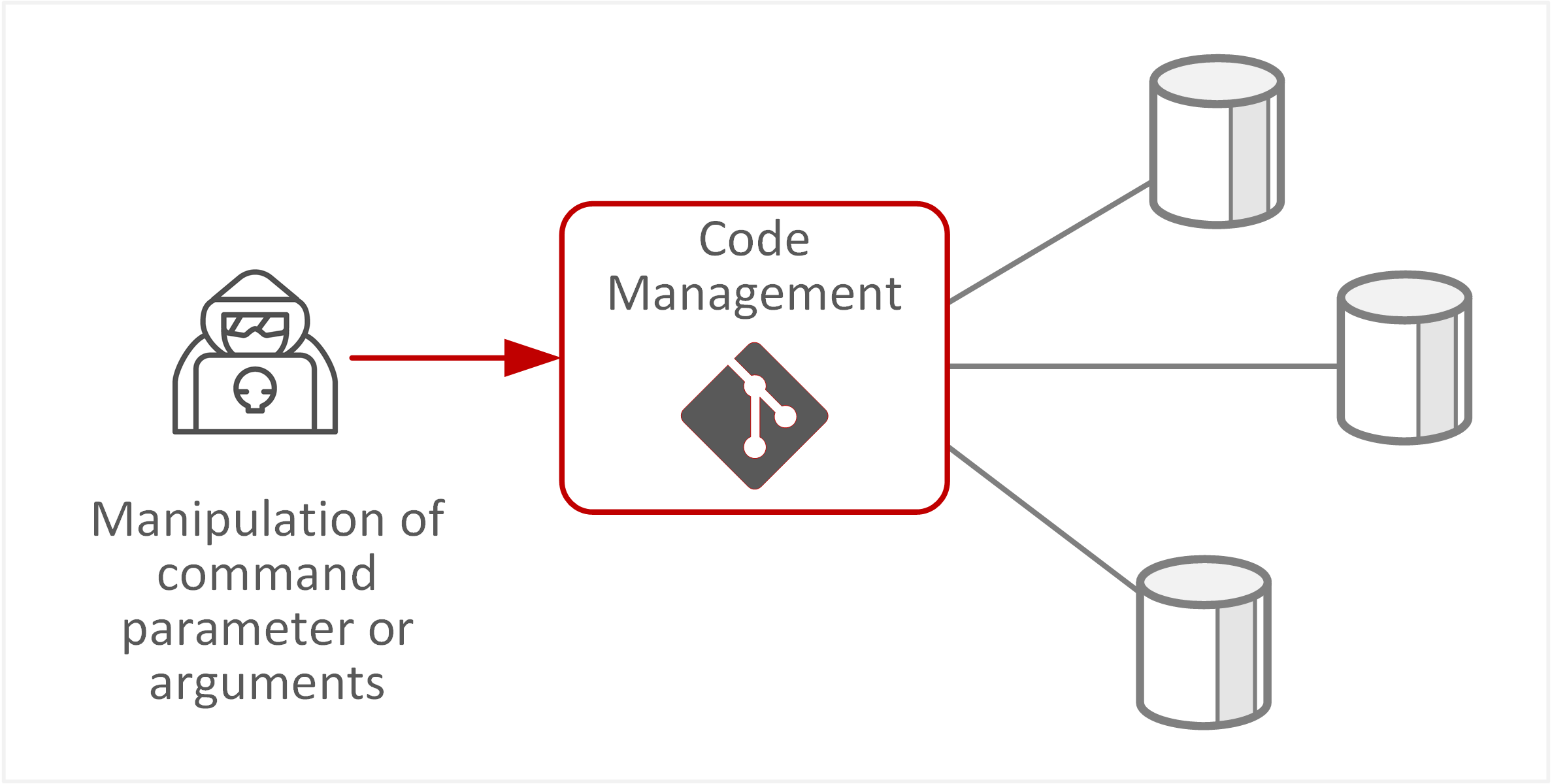 |
| TE-31: Unauthorised changes or manipulation of application functionality or code | Trusted internal or partner developers may intentionally commit vulnerable code or perform unauthorised changes with the intent to later exploit those weaknesses within the target application, system, or business processes. | 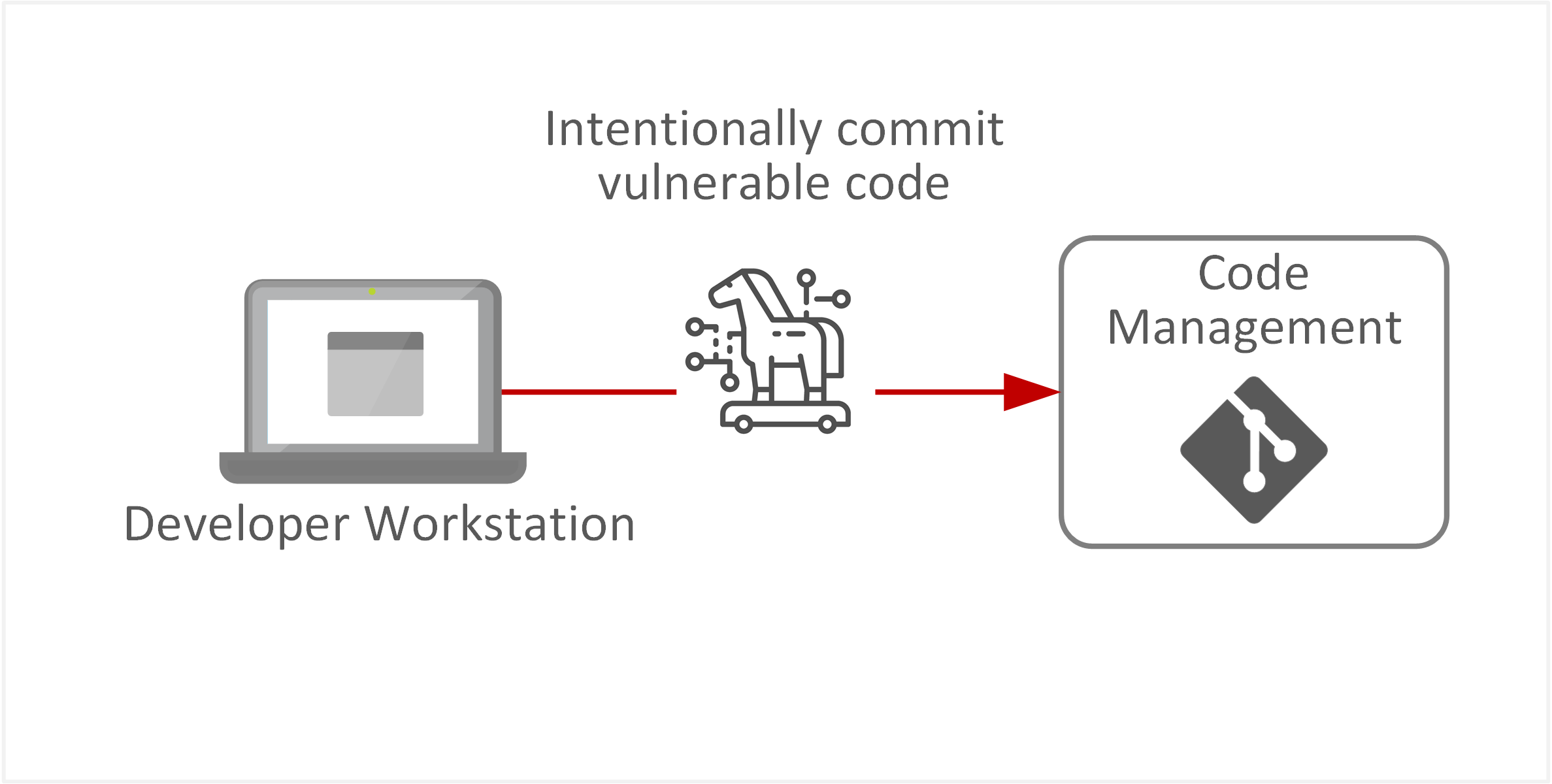 |
| TE-34: Violate isolation in multi-tenant environment | Tenant overlap between source code contributors could lead to code being committed incorrectly to the wrong code repository (with less permissive restrictions or controls) or subverting permissions boundaries across different source code repositories to perform unauthorised changes. | 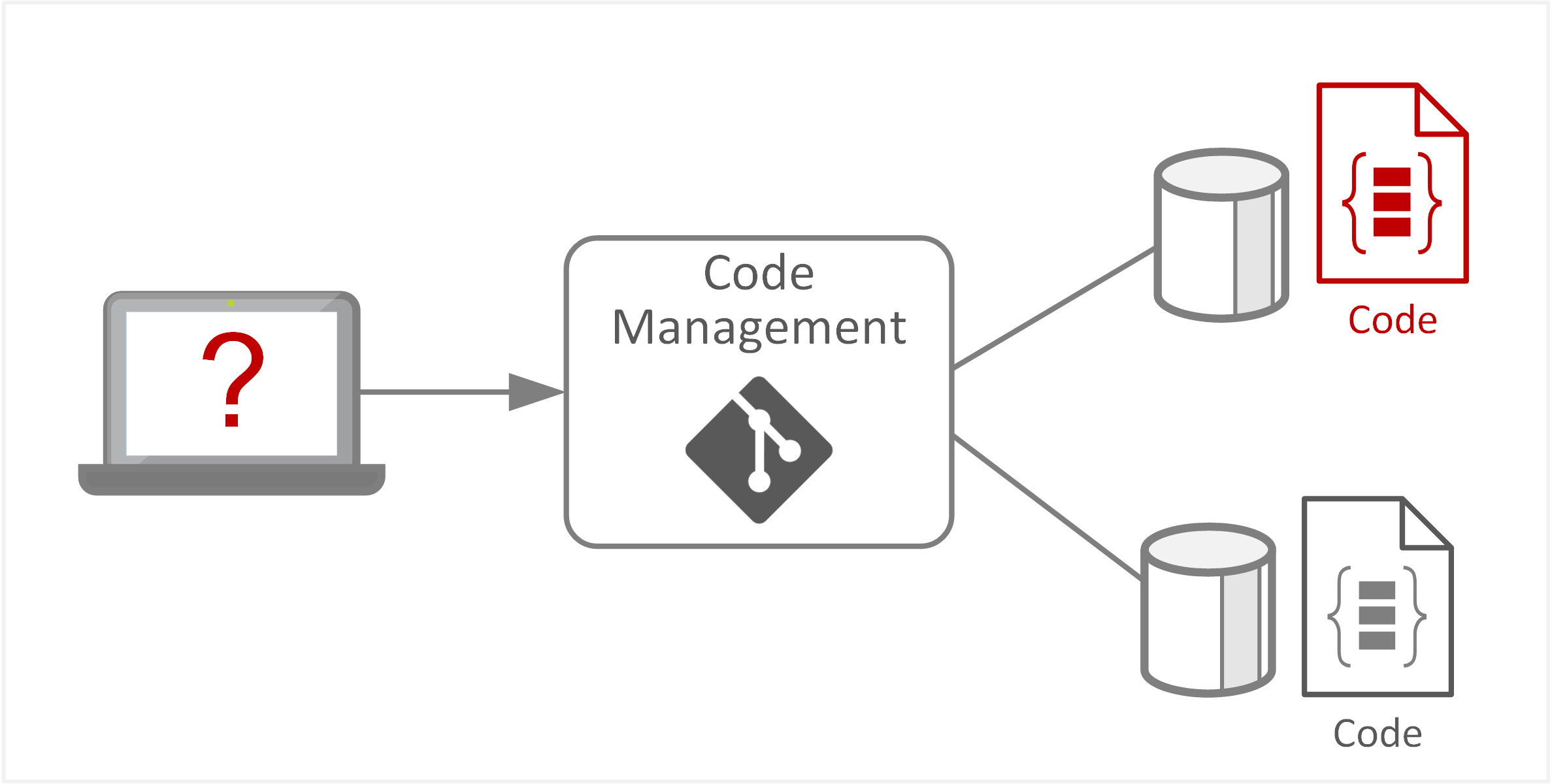 |
| TE-36: Unauthorised changes or manipulation of information data records | Unauthorised changes to git repositories through malicious insider actions or ransomware could intentionally encrypt or remove git repositories, causing unavailability or inaccessibility of source code. | 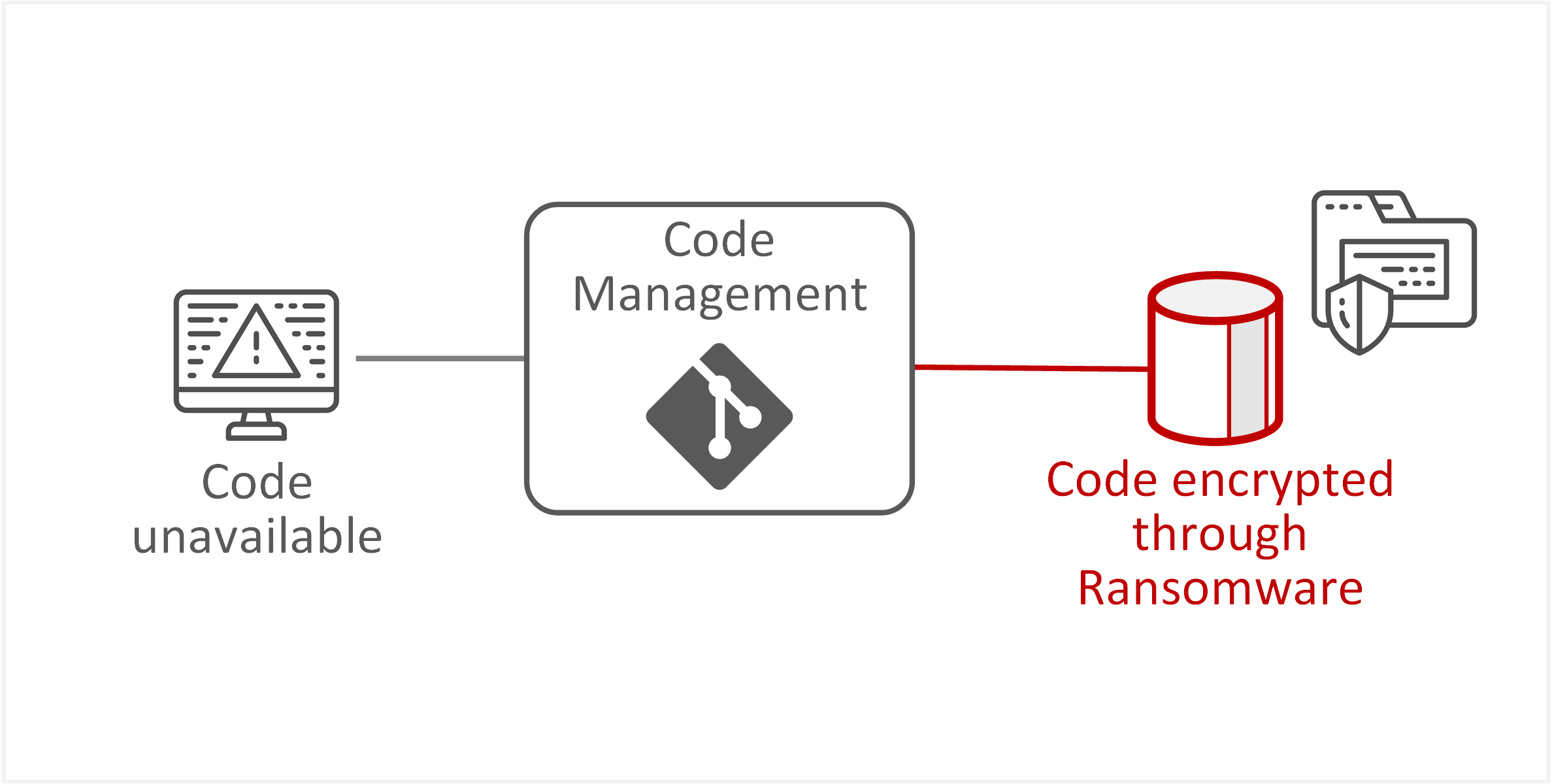 |
| TE-37: Compromise of confidential information or data breach | Confidentiality of source code could be compromised through lack of validation of external entities or third-party applications accessing source code repositories, leading to unauthorised access to source code. This could subsequently result in loss of intellectual property, exposure of sensitive workflows, or application functionality contained in code. | 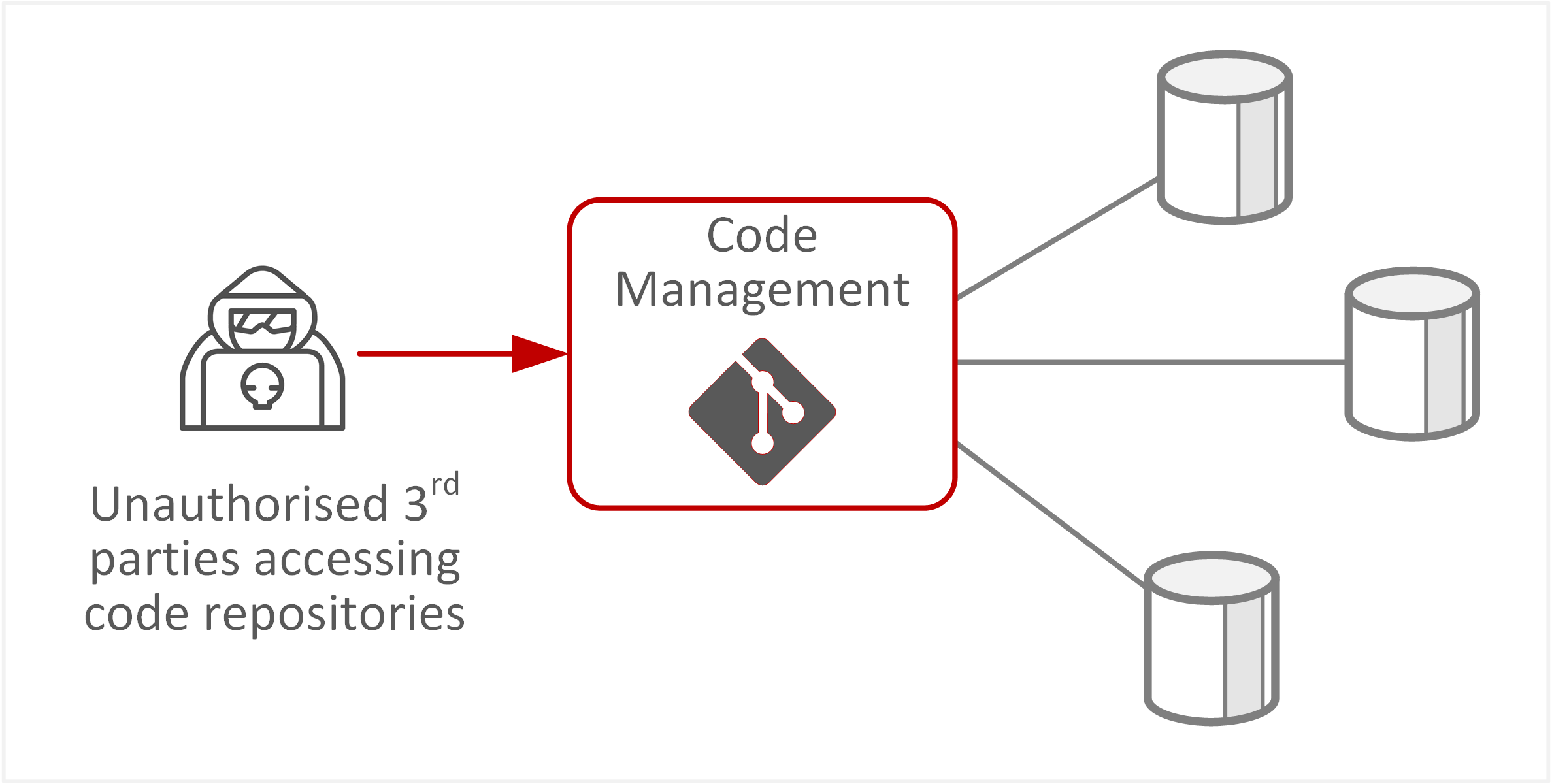 |
Target State Solution
Summary
The target state solution evaluates the following design requirements to provide the expected design principles for source code management.
Design Requirements
The target state solution is required to meet the following requirements, as referenced under Dependences, Assumption and Constraints.
| Requirement | Implication to Design Principles |
|---|---|
| 1. The scope and level of protection should be specific and appropriate to the asset at risk. | Maintain tighter protection policies for public GIT repositories to address associated external threats |
| 2. Security mechanisms must be pervasive, simple, scalable, and easy to manage. | The security pattern maintains clear security principles to be applied for source code management |
| 3. Assume context at your peril. | Controls defined in this security pattern are used to identify and measure problems, limitations or issues |
| 4. Devices and applications must communicate using open, secure protocols. | Open and encrypted communication channels such as SSH/HTTPS are applied for interfaces to source code management services |
| 5. All devices must be capable of maintaining their security policy on an un-trusted network. | Source Code Management is protected against both external and internal threats |
| 6. All people, processes, and technology must have declared and transparent levels of trust for any transaction to take place. | Repository owners ensure responsible for appropriate policies are in place across contributes for security |
| 7. Mutual trust assurance levels must be determinable. | Utilise industry frameworks such as OpenID and OAuth2 for authentication and authorization |
| 8. Authentication, authorization, and accountability must interoperate/exchange outside of your locus/area of control. | Apply authentication and authorization for both internal, partner and public clients |
| 9. Access to data should be controlled by security attributes of the data itself. | Source Code MAnagement maintains security attributes as metadata for each Git repository |
| 10. Data privacy (and security of any asset of sufficiently high value) requires a segregation of duties/privileges. | Utilise secrets management for securing sensitive data or credential |
| 11. By default, data must be appropriately secured when stored, in transit, and in use. | Ensure protection of both Public and Private Git repositories |
Solution Overview
The following represents the assets for source code management (SCM) across different trust domains and their interactions.
Public and private Git repositories have different security considerations and require separate security policies and configurations.
Private repositories may still be accessed by outsourced suppliers, business partners, or temporary developers. SCM and primary Git repositories may be synchronised or replicated to external locations for partners to access cached versions of designated repositories.

Additional Notes
- Connectivity to SCM for internal contributors is the same partner or public.
- Establish high levels of trust for contributors through identity and access management.
- All owners and contributors with access remain authenticated through a trusted identity provider.
- Validate the identity of all applications access SCM and where possible establish mutual trust.
- SCM ensures the integrity and non-repudiation for any source code changes (incl commits, push, pull, branches or merges)
- Different interfaces exposed by SCM (Command Line, Rest API interfaces, Webhooks) are protected regardless of source location of contributors (internal, partner, public)
- Access controls are considered against different types of developers for cloning, repository forking, branching, pull requests and merging
- Sequencing considers different access requirements during Development, Testing and Prod release phases.
- All Git workflows allow for secrets to be identified and or blocked during commits to git repositories.
- Repository owners ensure responsible for appropriate policies are in place across contributes for security.
Design Principles
The following design principles are applied to this pattern, based on the requirements.
- Never store secrets in code or configuration.
- Scan code for secrets and credentials during code commits
- Enable multi-factor authentication for contributors when available
- Validate any client or 3rd party applications requesting access
- Add security testing in your CI/CD pipelines to detect vulnerabilities
- Regularly rotate credentials such as SSH keys and access tokens used by developers.
- Maintain clearly separated trust boundaries and access policies between Public and Private GIT repositories
Actors
This pattern is involves following actors and entities
| Actor Type | Actor Description |
|---|---|
| System Administrator | Global permissions to manage SCM servers and repositories, maintain system configuration and policy and define code owners for repositories. |
| Security Administrator | Permissions to maintain security setting and services across SCM servers and repositories. |
| Repository Owner | Complete administrative access (merge, push, pull, fork) across one or more public / private repositories and manages git workflows for contributors. |
| Repository Collaborator | Trusted developers with read and write access to one or more repositories public / private repositories. |
| Restricted Collaborator | 3rd party partners or temporary access provided for read and some limited write access to one or more repositories. Maybe restricted to specific designated master and or branches. |
| Anonymous | Read only access to specific repositories designated as public. |
Locations
This pattern is applied to any locations for assets being utilised
| Location Type | Location Description |
|---|---|
| Hosting location for Source Code Management | Source Code Management and associated storage services maybe hosted internally or cached/sync into secondary locations for external partners or suppliers. |
| Access location to Source Code Management | Source Code Management may be made available to either Internal, Partner and or Public locations. |
Sequencing
The pattern is designed within the following sequences
| Sequence Phase | Sequence Description |
|---|---|
| Simple Git Workflow | This pattern works from a standard workflow, with changes and commits against just the Master repository. This pattern assumes no branches within workflows to simplify the design. |
Mapping Threats to Controls
The following provides a mapping of security threats to affected assets and the security control objectives required to mitigate them (further detailed in subsequent security pattern logical designs).
| Threat Event | Affects Assets | Mitigated by Security Controls |
|---|---|---|
| TE-09: Accidental leaks or sharing of information due to human error or mishandling | Source Code GIT Repositories – Public
Source Code GIT Repositories - Private Developer Workstations |
AC-16: Security and Privacy Attributes
AT-02: Awareness Training AU-13: Monitoring for Information Disclosure IR-04: Incident Handling IR-05: Incident Monitoring IR-09: Information Spillage Response SA-15: Development Process, Standards, and Tools SA-11: Developer Testing and Evaluation SA-16: Developer-provided Training SC-03: Security Function Isolation |
| TE-14: Inadequate workflows or processes leading to flaws in deployment | Source Code GIT Repositories – Public
Source Code GIT Repositories - Private |
AT-02: Awareness Training
AU-10: Non-repudiation PL-04: Rules of Behaviour SA-03: System Development Life Cycle SA-11: Developer Testing and Evaluation SA-15: Development Process, Standards, and Tools SC-35: External Malicious Code Identification SI-02: Flaw Remediation SI-05: Security Alerts, Advisories, and Directives |
| TE-16: Unintentional destruction of records through mismanaged data repositories or storage | Source Code Management and Version Control | CP-09: System Backup
CP-10: System Recovery and Reconstitution SC-24: Fail in Known State SC-28: Protection of Information at Rest SC-32: System Partitioning |
| TE-29: Web application attacks or code injection attack | Source Code Management and Version Control | AU-02: Event Logging
AU-03: Content of Audit Records AU-08: Time Stamps CA-08: Penetration Testing CM-02: Baseline Configuration PM-16: Threat Awareness Program RA-05: Vulnerability Monitoring and Scanning SA-11: Developer Testing and Evaluation SC-05: Denial of Service Protection SC-08: Transmission Confidentiality and Integrity SC-17: Public Key Infrastructure Certificates |
| TE-31: Unauthorized changes or manipulation of application functionality or code. | Source Code GIT Repositories – Public
Source Code GIT Repositories - Private CI/CD Pipelines |
AC-06: Least Privilege
AC-13: Supervision and Review — Access Control AU-02: Event Logging AU-03: Content of Audit Records AU-08: Time Stamps AU-10: Non-repudiation AU-16: Cross-organizational Audit Logging PL-04: Rules of Behaviour PM-12: Insider Threat Program PS-03: Personnel Screening PS-06: Access Agreements SA-03: System Development Life Cycle SA-10: Developer Configuration Management SA-11: Developer Testing and Evaluation SC-35: External Malicious Code Identification SI-02: Flaw Remediation |
| TE-34: Violate isolation in multi-tenant environment | Source Code Management and Version Control | AC-06: Least Privilege
AC-22: Publicly Accessible Content IA-02: Identification and Authentication (organizational Users) IA-09: Service Identification and Authentication IA-12: Identity Proofing SC-14: Public Access Protections SC-50: Software-enforced Separation and Policy Enforcement |
| TE-36: Unauthorized changes or manipulation of information data records | Source Code Management and Version Control
Developer Workstations |
AU-02: Event Logging
AU-03: Content of Audit Records CM-10: Software Usage Restrictions CP-09: System Backup CP-10: System Recovery and Reconstitution SC-28: Protection of Information at Rest SI-03: Malicious Code Protection |
| TE-37: Compromise of confidential information or data breach | Source Code GIT Repositories – Public | AC-14: Permitted Actions Without Identification or Authentication
AC-20: Use of External Systems AC-22: Publicly Accessible Content IA-08: Identification and Authentication (non-organizational Users) SA-06: Software Usage Restrictions SA-09: External System Services SC-14: Public Access Protections |
Security Pattern
Pattern View: Source Code Management

Control list: Source Code Management (SCM) and Version Control
| Control Objective | Control Description |
|---|---|
| AC-02: Account Management | Approve access based on roles assigned to individual and privileged users. Restrict permissions provided for global administrative access across repositories managed under SCM. |
| AC-03: Access Enforcement | Enforce mandatory access controls for both public and private git repositories and restrict access to interfaces for SCM services. |
| AC-06: Least Privilege | Default permissions enforce least privilege model for SCM |
| AC-22: Publicly Accessible Content | Only allow external access to git repositories explicitly defined as 'public' by repository owner. Notify and prompt contributors during pre-commit where codebase and content is being made publicly accessible. |
| AU-02: Event Logging | Enforce event logging across SCM services and system components. Forward and capture log events to centralised security logging and monitoring service. |
| AU-03: Content of Audit Records | Full audit logging must be enabled within SCM services including
|
| AU-08: Time Stamps | Ensure correct synchronisation of system time for time stamps within audit record generation, across all primary and replicated/sync repositories. |
| CA-08: Penetration Testing | Conduct regular security testing across SCM services and system to identify potential flaws or breaches system confidentiality or integrity. |
| CM-02: Baseline Configuration | SCM software operates with approved and hardened security configuration baseline. Source Code Management software is patched and up to date. Automate patching process where possible. |
| CM-10: Software Usage Restrictions | Assess and review any 3rd party software packages, plugin modules or applications requiring integration within SCM services. |
| CP-09: System Backup | Regularly backup and archive git repositories to alternate SCM services and secondary storage location, to protect against unintentional storage failures or intention data loss (malicious insider or ransomware) |
| CP-10: System Recovery and Reconstitution | Regularly validate both data and system recoverability of backup and archived git repositories to primary SCM services. |
| IA-02: Identification and Authentication (organizational Users) | All contributors with read/write access to private git repositories and write access to public git repositories are uniquely identified. No shared or generic account for users. Never let users share accounts/passwords used to access git repositories |
| IA-09: Service Identification and Authentication | All services or applications integrating with SCM are uniquely identified and authenticated. Where supported, enforce mutual authentication between services. |
| IA-12: Identity Proofing | Validate and verify user’s identity prior to issuing credentials or API Keys for accessing SCM system. This maybe through use of trusted identity management service or establish own identity proofing process. |
| PM-16: Threat Awareness Program | Review SCM vendor for commitment to identifying vulnerabilities within their software and or participation in bug bounty programs |
| RA-05: Vulnerability Monitoring and Scanning | Conduct regular vulnerability scanning and monitoring across SCM services and software. |
| SC-05: Denial of Service Protection | Enforce protective measures to block or limit the effect of DOS attacks to SCM services and/or public git repositories |
| SC-08: Transmission Confidentiality and Integrity | Encrypt all channels for access (SSH, HTTPS), including Rest API and webhooks. |
| SC-14: Public Access Protections | Assign IP whitelisting to restrict access to private git repositories from untrusted network locations and all access via trusted remote access services. |
| SC-17: Public Key Infrastructure Certificates | Enforce SSH mutual authentication and shorten session times to SCM services where possible. |
| SC-24: Fail in Known State | Ensure and regularly test for recoverability of SCM services during potential failure of underlying platform and or dependant infrastructure. |
| SC-28: Protection of Information at Rest | Encrypt all data at rest whenever applicable, including git repositories stored managed within database and or file systems. |
| SC-32: System Partitioning | Enforce clear separation and isolation within SCM services for git repositories identified as public and those restricted as private. |
| SC-50: Software-enforced Separation and Policy Enforcement | Maintain additional whitelisted access for CI/CD servers and only provide access required to pull codebase from repository and build it. Enforce explicit rules governing the installation of software including 3rd party modules, plugins or applications with access to SCM services. |
| SI-03: Malicious Code Protection | SCM system and services have Endpoint Protection enabled for anti-malware and intrusion prevention. |
Control list: Source Code GIT Repositories – Public
| Control Objective | Control Description |
|---|---|
| AC-03: Access Enforcement | Enforce discretionary access restrictions for all contributors with full write permissions and require additional 2-factor-authentication on their accounts. |
| AC-06: Least Privilege | Repository owners manage access to source code and data within principles of least privilege. Only give contributors access to the data they need to do their role. |
| AC-13: Supervision and Review — Access Control | Security team periodically review developer practises and compliance with secure coding best practises. |
| AC-14: Permitted Actions Without Identification or Authentication | Read access is permitted to anonymous users for codebase marked as public. Write access is not be permitted for anonymous users |
| AC-16: Security and Privacy Attributes | Codebase maintains a SECURITY.MD file that provides general security-related information for the project including disclosure policy, security update policy and contact information for identified vulnerabilities or bug bounties. |
| AT-02: Awareness Training | Security practices for code management are maintained in an easy-to-find document for both repository owners and contributors. |
| AU-02: Event Logging | Enforce event logging across public git repositories, specifically for changes to repositories. Forward and capture log events to centralised security logging and monitoring service. |
| AU-03: Content of Audit Records | Audit logging is enabled for code changes and commits including
|
| AU-08: Time Stamps | Ensure correct synchronisation of system time for time stamps within audit record generation |
| AU-10: Non-repudiation | Enforce PGP/GPG signed commits for contributors committing code to git repository. |
| AU-13: Monitoring for Information Disclosure | Periodically scan codebases within git repositories for secrets that may have been committed. Trigger incident management process if secrets have been identified. |
| IA-08: Identification and Authentication (non-organizational Users) | Uniquely identify access to public git repositories where possible, such as source location metadata (IP address). |
| IR-04: Incident Handling | Incident management processes cover the handling of
|
| IR-05: Incident Monitoring | Regularly scan and monitor for vulnerable code or commit that contain secrets. Additionally, place honeypot secrets within sample code and monitor use of those secrets to detect potential incidents or breaches. |
| PL-04: Rules of Behaviour | Repository owners outline clear guidelines to contributors and developers to coding practises and norms regarding git workflows and changes. |
| PM-12: Insider Threat Program | Regularly monitor or peer review contributors at regular intervals to ensure compliance with coding best practises, workflows and level of access permissions granted remains appropriate. |
| PS-03: Personnel Screening | Ensure documented process and plan for both onboard new hires and offboard exiting for any contributor with change or write access. |
| PS-06: Access Agreements | Ensure clearly documented access agreements for any contributor with change or write access. | SA-11: Developer Testing and Evaluation | Analyse and scan for secrets during code commits to identify any sensitive information such as password, API Keys or SSH private keys being placed into git repository. |
| SC-03: Security Function Isolation | Developers utilise purpose-built secrets management service to prevent sensitive administrative, system or application credentials stored on workstation or git repositories. |
| SI-05: Security Alerts, Advisories, and Directives | Monitor security advisories and feeds for updates in security best coding practises or hygiene. Regularly check repositories for appropriate security configurations. |
Control list: Source Code GIT Repositories - Private
| Control Objective | Control Description |
|---|---|
| AC-03: Access Enforcement | Enforce discretionary access restrictions for all contributors with full write permissions and require additional 2-factor-authentication on their accounts. |
| AC-06: Least Privilege | Repository owners manage access to source code and data. Only give contributors access to the data they need to do their role. Manage fine grained permissions where available to control who can push commits to which branches. |
| AC-13: Supervision and Review — Access Control | Security team periodically review developer practises and compliance with secure coding best practises. |
| AC-16: Security and Privacy Attributes | Codebase maintains a SECURITY.MD file that provides general security-related information for the project including security update policy, details for secrets management vault(s) and or security hardening requirements. |
| AU-02: Event Logging | Enforce event logging across git repositories. Forward and capture log events to external security logging and monitoring service. |
| AU-03: Content of Audit Records | Audit logging is enabled for code changes and commits including
|
| AU-08: Time Stamps | Ensure correct synchronisation of system time for time stamps within audit record generation across any private git repositories including secondary remote or partner locations. |
| AU-10: Non-repudiation | Enforce PGP/GPG signed commits for contributors committing code to git repository. |
| AU-13: Monitoring for Information Disclosure | Periodically scan codebase within git repositories for secrets that may have been committed and. Trigger incident management process if secrets have been identified. |
| AU-16: Cross-organizational Audit Logging | Capture audit logs from both primary git repositories and any replicated/sync secondary git repositories located in remote or partner sites. |
| IR-04: Incident Handling | Incident management processes covers the handling of
|
| IR-05: Incident Monitoring | Regularly scan and monitor for vulnerable code or commit that contain secrets. Additionally, place honeypot secrets within sample code and monitor use of those secrets to detect potential incidents or breaches |
| PL-04: Rules of Behaviour | Repository owners outline clear guidelines to contributors and developers to coding practises and norms regarding git workflows and changes. |
| PM-12: Insider Threat Program | Repository owners and security team monitor for unusual changes or behaviour across internal and partner teams. Establish honeypots within specific codebase(s) to identify any potential insider threats attempting compromise confidentiality or integrity of repositories. |
| PS-03: Personnel Screening | Ensure documented process and plan for both onboard new hires and offboard exiting for both internal staff, external 3rd party partners or temporary developers. |
| PS-06: Access Agreements | Ensure clearly documented access agreements for any 3rd party partner, outsource provider or temporary developers with access to private git repositories. |
| SA-11: Developer Testing and Evaluation | Analyse and scan for secrets during code commits to identify any sensitive information such as password, API Keys or SSH private keys being placed into git repository. |
| SI-05: Security Alerts, Advisories, and Directives | Monitor security advisories and feeds for updates in security best coding practises or hygiene. Regularly check repositories for appropriate security configurations. |
Control list: Developer Workstations
| Control Objective | Control Description |
|---|---|
| AC-16: Security and Privacy Attributes | Developers and contributors maintain SECURITY.MD files for code bases that they actively work on or make changes. |
| AT-02: Awareness Training | Provide awareness training to all contributors and developers for security hygiene and how to manage vulnerable components, configuration mistakes or leaked secrets. |
| CM-10: Software Usage Restrictions | Developers utilise approved software and tooling for code development to avoid potential data leakage or compromise of source code. |
| IR-09: Information Spillage Response | Developers are trained and prepared for processes involved leaked credentials or secrets, and steps required to invalidate credentials, tokens and passwords that were compromised |
| SA-15: Development Process, Standards, and Tools | Developers operate within provided guidelines for development practises and behaviours. Developers periodically refresh and rotate SSH Keys or credentials used for accessing SCM. |
| SA-16: Developer-provided Training | Developer education require best practises for secure coding (such as OWASP Secure Coding Practises). Developers maintain regular code check-ins and clear documentation for security related changes or features in codebase. |
| SC-03: Security Function Isolation | Developers utilise secrets management services to prevent sensitive information or credentials associated to codebase being stored on workstation. |
| SC-28: Protection of Information at Rest | Developer workstation, laptops or devices with access to git repositories are properly secured including encryption at rest. |
| SI-03: Malicious Code Protection | Developer workstation have endpoint protection enabled for anti-malware and intrusion prevention. |
Control list: CI/CD Pipelines
| Control Objective | Control Description |
|---|---|
| AC-13: Supervision and Review — Access Control | Periodically review developer practises and compliance with standard workflows. |
| AU-02: Event Logging | Enforce event logging across CI/CD pipelines. Forward and capture log events to centralised security logging and monitoring service. |
| AU-03: Content of Audit Records | Audit logging is enabled for changes to workflows or pipelines regarding code development including
|
| AU-08: Time Stamps | Ensure correct synchronisation of system time for time stamps within audit record generation across tooling. |
| AU-10: Non-repudiation | Ensure digitally signed artefacts for approvals in workflows and stage gates, particular for security related functions or testing. |
| PL-04: Rules of Behaviour | Standardise and automate workflows where ever possible to enforce rules of behaviour for software development practises |
| PM-12: Insider Threat Program | Monitor for deviations or unauthorised changes to developer workflows or CI/CD pipeline. |
| RA-10: Threat Hunting | Identified vulnerabilities trigger either failed pull requests or failed build. Block vulnerable code from being merged and alert contributors of findings. |
| SA-03: System Development Life Cycle | Ensure secure development lifecycle and workflows from Blueprint to Execution. Apply tighter access and change restrictions to higher level production environments. |
| SA-11: Developer Testing and Evaluation | Apply security testing within CI/CD pipeline including peer review, static code analysis and or dynamic code analysis/sandboxing. |
| SC-35: External Malicious Code Identification | Scan for external dependencies within codebase for potential vulnerabilities or malicious code. Block pull requests from being merged for new vulnerabilities identified and alert contributors of findings. |
| SI-02: Flaw Remediation | Remediated vulnerabilities committed within codebase is clearly documented and tracked to prevent re-introduction during any code rollback or new branches. |
Appendix A – References
Please see below links to external sites for further reading
- https://resources.github.com/whitepapers/Nine-software-security-best-practices/
- https://resources.whitesourcesoftware.com/blog-whitesource/top-5-git-security-mistakes
- https://snyk.io/blog/cheat-sheet-10-bitbucket-security-best-practices/
- https://www.upguard.com/articles/bitbucket-vs-github
- https://www.cvedetails.com/vulnerability-list/vendor_id-3578/product_id-36995/Atlassian-Bitbucket.html
- https://linuxacademy.com/blog/linux/git-terms-explained/
- https://buddy.works/blog/5-types-of-git-workflows
Appendix B - Disclosure Notice
This document is published as independent research only and is without warrenty. It does not represent any publication from National Institute of Standards and Technology (NIST) or other associated US government entities.
